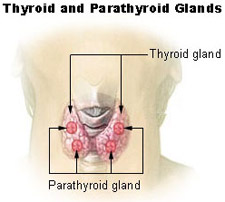Thyroid & Parathyroid Glands
Thyroid Gland

The thyroid gland is a very vascular organ that is located in the neck. It consists of two lobes, one on each side of the trachea, just below the larynx or voice box. The two lobes are connected by a narrow band of tissue called the isthmus. Internally, the gland consists of follicles, which produce thyroxine and triiodothyronine hormones. These hormones contain iodine.
About 95 percent of the active thyroid hormone is thyroxine, and most of the remaining 5 percent is triiodothyronine. Both of these require iodine for their synthesis. Thyroid hormone secretion is regulated by a negative feedback mechanism that involves the amount of circulating hormone, hypothalamus, and adenohypophysis.
If there is an iodine deficiency, the thyroid cannot make sufficient hormone. This stimulates the anterior pituitary to secrete thyroid-stimulating hormone, which causes the thyroid gland to increase in size in a vain attempt to produce more hormones. But it cannot produce more hormones because it does not have the necessary raw material, iodine. This type of thyroid enlargement is called simple goiter or iodine deficiency goiter.
Calcitonin is secreted by the parafollicular cells of the thyroid gland. This hormone opposes the action of the parathyroid glands by reducing the calcium level in the blood. If blood calcium becomes too high, calcitonin is secreted until calcium ion levels decrease to normal.
Parathyroid Gland
Four small masses of epithelial tissue are embedded in the connective tissue capsule on the posterior surface of the thyroid glands. These are parathyroid glands, and they secrete parathyroid hormone or parathormone. Parathyroid hormone is the most important regulator of blood calcium levels. The hormone is secreted in response to low blood calcium levels, and its effect is to increase those levels.
Hypoparathyroidism, or insufficient secretion of parathyroid hormone, leads to increased nerve excitability. The low blood calcium levels trigger spontaneous and continuous nerve impulses, which then stimulate muscle contraction
Suggested Citation
SEER Training Modules: Thyroid & Parathyroid Glands. U.S. National Institutes of Health, National Cancer Institute. Cited 04 January 2026. Available from: https://training.seer.cancer.gov.




